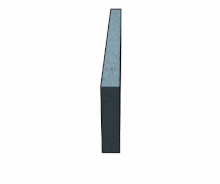Spallation
Spallation (from English to spall , "splinter") is a non-elastic interaction of a projectile with its target object.
Spallation in solids
In fracture mechanics , spallation can occur when a pressure pulse travels through a material and is reflected on the free surface as a tensile pulse. The stresses caused by this can exceed the maximum tensile strength of the material and thus create cavities that can lead to one or more tensile fractures or even to the material flaking off.
This type of spallation occurs, for example, at the edge of impact craters due to the shock waves hitting the free surface (e.g. planetary surface) .
Nuclear Spallation
In nuclear spallation, an atomic nucleus is bombarded with a projectile ( neutron , proton , another nucleus or an elementary particle ) of high kinetic energy (> 100 MeV ). The atomic nucleus is shattered into smaller fragments and usually several neutrons.
The spallation reaction takes place in two stages. The projectile initially interacts with the individual nucleons of the target core , which in turn interact with other nucleons, so that a particle cascade is created within the target core. Some of these protons and neutrons leave the target core with energies up to the original energy of the projectile. The main direction of the emitted particles coincides with the direction of the projectile. With projectile energies greater than 400 MeV, pions can also be generated.
What remains is a highly excited residual nucleus in which the kinetic energy is statistically evenly distributed over all nucleons. The second stage of the spallation reaction then consists of the "evaporation" of neutrons and protons - less often of α-particles and other nuclear fragments - from the target nucleus. These nucleons have energies up to 10 MeV and an isotropic angular distribution . The remaining core is usually still unstable and therefore radioactive .
The first stage of the reaction takes about 10 −22 seconds. This is the time it takes for the projectile to travel through the core. The second stage takes about 10-16 seconds.
In nature, spallation reactions occur e.g. B. in the interaction of cosmic rays with interstellar or interplanetary matter. For example, by measuring the frequency of reaction products formed by spallation, e.g. B. certain noble gas isotopes, the irradiation age are determined in meteorites . Technically, spallation is used in spallation neutron sources to generate neutrons, which can be an alternative to their usual generation in research reactors . Spallation neutron sources are also being considered for the disposal of nuclear waste by transmutation . In Europe there is currently the short pulse source ISIS near Oxford, which works with neutron pulse lengths in the microsecond range, as well as the continuous source SINQ in Switzerland. The larger European spallation source ESS is scheduled to go into operation in Lund , Sweden in 2023 .
Web links
- Homepage of SINQ, Swiss source of spallation
- Spallation Neutron Source (SNS) - Spallation neutron source of the Oak Ridge National Laboratory in the USA.
- European Spallation Source project in Lund, Sweden
Individual evidence
- ↑ The magical defusing of nuclear waste faz.net, accessed on August 20, 2013
- ↑ ESS timeline. Retrieved March 8, 2020 .
